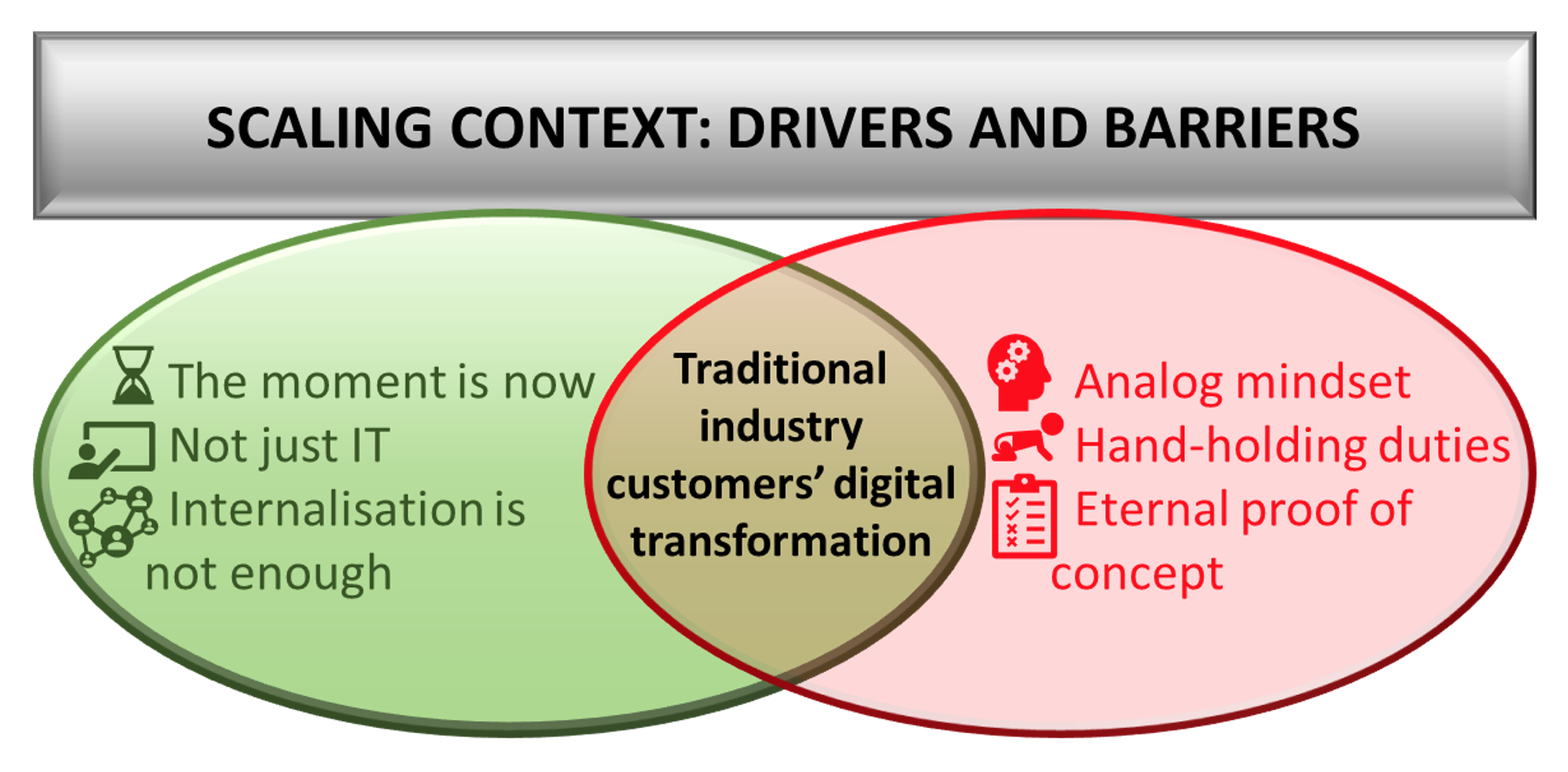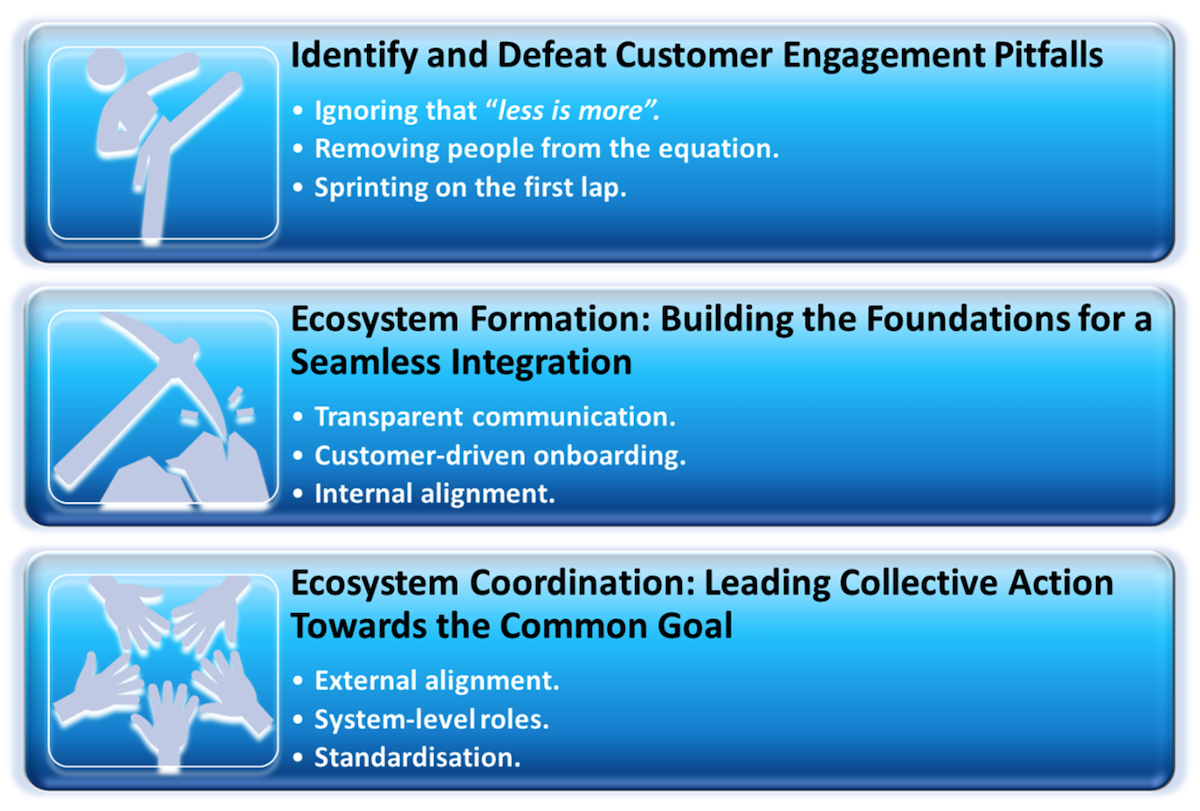California Management Review
California Management Review is a premier academic management journal published at UC Berkeley
by Patricia Carolina Garcia Martin, Nikolina Koporčić, Vinit Parida, and David Sjödin

Image Credit | Alex Wong
In recent years, we have witnessed an exponential increase in the development and provision of digital solutions powered by the advancement and accessibility of technology. Given their dynamism and flexibility, small firms hold a privileged position to take advantage of such digitally driven opportunities. While digital solutions tend to grow faster in knowledge-intensive and fast-paced markets, their potential creates greater expectations in traditional industries where radical innovation is less common. To remain competitive, industries such as mining, processing, and manufacturing are undergoing a digital transformation, yet their efforts alone are not enough to leverage the potential that the digital world brings to the table. In this context, small innovative firms are taking the lead in providing digital solutions to traditional industry customers.1 Digitally advanced products and services continue to emerge to best satisfy industry needs, yet adoption rates do not match the initial expectations of customers. This digital maturity gap represents a further barrier to many small firms who are already constrained by the liability of smallness and newness. As a result, the scale-up of digital solutions becomes a mission impossible in such slow-moving industries.2
“Strategies for Digitalization in Manufacturing Firms” by Joakim Björkdahl. (Vol. 62/4) 2020.
“How Can Large Manufacturers Digitalize their Business Models? A Framework for Orchestrating Industrial Ecosystems” by David Sjödin, Vinit Parida, & Ivanka Visnjic. (Vol. 64/3) 2021.
“Ready or Not: Managers’ and Employees’ Different Perceptions of Digital Readiness” by Anne Gfrerer, Katja Hutter, Johann Füller, & Thomas Ströhle. (Vol. 63/2) 2020.
Our team of authors has been working extensively with small innovative firms who are trying to contribute to the digital revolution in the Nordic industrial regions. Through our numerous interactions, interviews, and workshops, we have gained a close understanding of the challenges associated with traditional industry customers. Nevertheless, we have witnessed the resilience and the determined response of firms not just to survive but to thrive in such environments. We would like to share our lessons learned and hope that this will encourage firms in a similar situation to complete their mission. The remainder of this article is divided into two main blocks. First, we provide a contextualisation of traditional industries and the barriers they present to small firms seeking to commercialise innovative solutions. Next, we address the question of how to configure a scale-up journey to succeed in traditional industries. In doing so, we provide strategic advice to overcome customer engagement pitfalls, and we elaborate on the best practices in ecosystem building.
Traditional industries are characterized by labour-intensive and large-scale operations that have existed and have remained unchanged for a very long time. Examples include mining, equipment manufacturing, processing of materials, construction, and forestry. From an innovation point of view, such industries tend to be considered laggards in the adoption of new practices and tools. The evolution and accessibility of new technologies are quickly reshaping the competitive landscape, with many of these organisations now fighting for a seat in the first row of the digital transformation3:
The moment is now. The changes prompted by the recent global pandemic have forced traditional industries to face an accelerated digital transformation. While some organisations have lacked the motivation to implement drastic changes in their ways of working, the sudden collapse of operations brought on by COVID-19 forced a digital push across all business segments. The pandemic has demonstrated that digitalization is not an option but the new status quo for resilient and competitive industries in the globalised economy.
Not just IT. The opportunities generated by digital technologies impact the entire organisation, moving from timid upgrades to holistic innovation projects. A new culture of innovation is emerging in traditional industries, where not just IT but all employees need to embrace.4 While adaptation to new technologies is encouraged, new roles and responsibilities are being created to cope with the exponential growth of digital opportunities. Upskilling and talent acquisition have become both the kryptonite and the strength of traditional HR departments in the hunt for digitally savvy people.
Internalisation is not enough. The early bird catches the worm or, in business terms, early adopters benefit from first mover advantage. Traditional industries, although resourceful and motivated, lack the agility needed to anticipate and timely exploit the wonders of digital technologies. Established priorities, parallel projects, and working habits, among others, impel them to partner with digital providers rather than internalise specific digitalization projects.5 This scenario becomes the perfect opportunity for small innovative firms to design and implement digital solutions that match the needs of traditional industry customers.

Figure 1. The Mission Impossible: Scaling Digital Solutions in Traditional Industries
We view scaling digital solutions as the journey that goes beyond initial market penetration and into market growth, characterised by the expansion of the customer base and/or the expansion of the offering. Even though traditional industry customers want to, and need to, leverage digital opportunities, the transformation cannot happen in a day, setting tight boundaries to the desired market growth. Understanding that digitalization is the way forward is not enough; there is still the need to educate traditional industry customers. Based on our data, we have identified three main barriers constraining the scale-up in traditional industries:
Analog mindset. The intangible nature of digital innovations represents a barrier to demonstrating the value of the solution in traditional industries, where customers’ digital readiness tends to be low and is evolving at a slow pace.6 This situation is aggravated by the liability of newness of small firms, whose brand cannot compete with the trust already generated by the larger technological corporations in the market.
Hand-holding duties. An important opportunity presented by digital technologies is the ability to translate large amounts of usage data into continuous improvements in the solution. While small firms have the capabilities to successfully develop the required upgrades to better satisfy customer needs, customers often lack the capabilities to experience the resulting added value. Given their limited capacity, hand holding customers on every step of their digital transformation journey is not something that small firms can easily accede to with so much already on their plates.
Eternal proof of concept. The innovativeness of the solution challenges its implementation in traditional industries, where customers require subsequent testing phases, making it hard to move from the pilot project to the commercial stage. Even though the solution is ready to be up and running, it is frequently treated as a proof of concept and needs to be dealt with by the customer’s R&D department. This requirement represents a burden for both parties – the customer struggles to prioritise the additional project, and the small firm struggles to maintain momentum over time.
Our research revealed that there is not a single or best way to scaling. Indeed, there are various avenues that firms need to assess according to their unique characteristics. However, customer engagement and ecosystem building stand out among the requirements that decision makers need to pay attention to when configuring their journey towards a successful scale-up in traditional industries.
We define customer engagement as the way a firm builds and maintains customer relationships over time, characterised by establishing and nurturing the relationship. Enforcing a customer-oriented mindset across the firm is key to the long-term success of the scale-up journey. Working closely with customers makes it possible to develop the required industry knowledge to determine whether to pursue a specific customer’s commitment. Based on our experience with small innovative firms, we identified several customer engagement pitfalls and how best to address them.
Ecosystems constitute fast-paced collaborative environments where heterogenous and interdependent participants join forces to reach a common higher-level goal.7 In the case of small innovative firms, ecosystems are enabling and unveiling new ways of pursuing the scaling of digital solutions in traditional industries. Although there are benefits in being part of an ecosystem, it does not come without challenges, especially when firms are trying to leverage its potential. Their boundaryless structure and unpredictable evolution make ecosystems hard to orchestrate and manage. Our work with small firms has revealed a set of best practices that can help decision makers tackle the complexity associated with the formation and coordination of the ecosystem.
Engaging customers is never an easy task, and the particularities of traditional industry customers pose an added degree of complexity. Below, we present three main pitfalls that can sabotage engagement efforts, threatening customer relationships in traditional industries. But fear not, we have learned the value of strategic responses and can provide you with advice on how best to secure customer engagement.
Ignoring that “less is more”. The wide potential and impact of digital solutions often translate into overcomplicated value propositions for the customer. Value creation is crucial to establish the relationship, yet presenting all the benefits and applications of the solution will often have the opposite effect in traditional industries. A way to tackle this issue is to build on an ongoing customer case (e.g., productivity project, operational problem, ways of working) and show how the digital solution can create added value. Showing live results on the first meeting, rather than ideal scenarios or complex demos, is a key strategic action that will win trust, even from the most digitally sceptic customer.
Removing people from the equation. Digital solutions are powered by technology but leveraged by people. Focusing on customers’ technical stakeholders can lead to overlooking other important roles needed for the digital solution to take off. Being able to “speak the language” of IT technicians is as important as that of management and end users in the customer organisation. A way to master this skill is to understand the customer’s structure (i.e., divisions, responsibilities, decision power) and to engage multiple stakeholders from the early stages of implementation. Establishing ties with several problem owners supports the customer’s commitment to the solution and facilitates further upgrades based on diverse usage experiences.
Sprinting on the first lap. Digital readiness varies across customers, with traditional industries being less mature in this regard. Assuming that customers “will just know” how to handle the transition to a digitized workplace or proposing major changes too fast are common pitfalls that result in the digitalization journey being cut short. Change management must be at the forefront of customer engagement processes, aiming to simplify the integration through steady and continuous adaptation. A way to deal with low digital readiness is to ensure the digital solution provides small wins that can create sufficient value to keep the customer motivated throughout the process. Another strategic manoeuvre is to find a champion to drive change from within, a mover and shaker who can help break customer silos and secure incremental changes internally.

Figure 2. Achieving the Mission: Configuring a Successful Scale-up Journey
Ecosystem formation is not a linear process but rather an iterative journey where firms connect with each other and evaluate becoming part of a collective system. Creating a common vision, attracting partners, and stimulating win-win scenarios constitute crucial milestones during the early stages of ecosystems. Our research has shown how small innovative firms pursue the formation of an ecosystem to achieve seamless integration of digital solutions in traditional industries. We identified transparent communication, customer-driven onboarding, and internal alignment as best practices:
Transparent communication. When forming the ecosystem, a key aspect is to ensure a common understanding that will arouse participants’ desire to join and work towards win-win scenarios. A transparent communication strategy can help to map out the priorities while clarifying the benefits for participants in the ecosystem. Visibility and simplicity of the digital solution are encouraged to reduce the technological gap between industrial and digitally savvy participants. Online and offline presence (e.g., LinkedIn, Expos) was also found to be critical during the formation phase, when the ecosystem is yet to be widely recognised by potential participants in the industry.
Customer-driven onboarding. Participants’ contribution to the ecosystem cannot be understood without knowing customer needs and how to best satisfy them. Customer-driven onboarding is a practice that aims to ensure the alignment of participants with customers, setting the basis for ecosystem competitiveness. For instance, compatibility with already established customers’ suppliers is an important selection criterion to minimise data-sharing and connectivity problems in the ecosystem. The onboarding process must be well informed, cover several channels, and evolve with customers’ operational and digital needs.
Internal alignment. The ecosystem consists of heterogeneous participants, who are intrinsically complex. Internal organisational alignment has been identified as a pre-requisite for successful ecosystem formation and development. Creating a common ground inside the firm helps to ensure that all employees are aware and willing to commit to the ecosystem vision. For instance, formally allocating time and resources so that employees can develop and maintain relationships with participants will strengthen ecosystem bonds and create barriers to outsider replication.
Ecosystem coordination requires continuous assessment of current and future outcomes to ensure participants are collectively moving in the desired direction. Defining routines, distributing roles, and ensuring participants’ cooperation enable the effective management and exploitation of ecosystem participants and outcomes. While coordination requires prioritising the common over the individual benefit, the risk of opportunistic behaviours increases in an ecosystem with highly heterogeneous participants. Our findings point to external alignment, system-level roles, and complementary sharing as practices that will best satisfy the need for coordination in ecosystems:
External alignment. Ecosystems are in constant evolution, requiring participants to learn from each other and to ascertain how to collaborate appropriately and adapt over time. Ensuring alignment among participants was seen as a crucial practice to strengthen the agility and responsiveness of the ecosystem against possible crises. For instance, dealing with cultural and attitudinal issues as part of the process of due diligence supports trust building, which can increase the long-term resilience of the ecosystem. We also identified meeting other participants face to face as a means to benefit alignment. This real-life contact is even more valued in circumstances where interactions are overly digitalized.
System-level roles. The whole is greater than the sum of the parts. Keeping track of and continuously reviewing the results of participants’ performance is of vital importance to effectively coordinate and promote ecosystem growth. Designing system-level roles was identified as a practice that emphasizes collective outcomes while considering individual strengths. For instance, revitalising a particular role is closely linked to its contribution to achieving future goals as well as its current and potential connections with other participants in the ecosystem.
Standardisation. Ecosystem complementarities enable participants to use knowledge, resources, and capabilities in an aggregate manner to achieve goals otherwise unattainable on their own. Focusing on flexible growth over time requires the ecosystem to evolve accordingly. Standardisation of processes and products facilitate and encourage integration among ecosystem partners. For instance, open software and convergence of user interfaces support integration while creating future opportunities for technology development.
The importance of small innovative firms in the digital transformation of traditional industries is evident. However, we should not forget that scaling in such contexts does not come without challenges. The complexity associated with different working mindsets, digital maturity, and digital capabilities can dim the initial excitement and cut short the journey on which small firms are embarked. Our lessons learned demonstrate the complexity of customer engagement processes, highlighting the particularities of traditional industries. We are committed to reducing uncertainty and supporting the establishment and nurturing of customer relationships in such promising but opaque organisations. In this article, we have identified three main pitfalls in pursuing engagement efforts, and we have laid out key strategic actions that can be deployed to secure this engagement. In addition, we have pointed out the need to build – and, indeed, the complexity of building – the right ecosystem for the commercialisation of digital solutions in traditional industries. The formation and coordination practices we have identified require sustained effort, which is vital if the long-term resilience and competitiveness of the ecosystem is to be assured. It is undoubtedly a challenging task, but the benefits of applying such best practices outweigh the constraints.
Kolagar, M., Reim, W., Parida, V., & Sjödin, D. (2021). Digital servitization strategies for SME internationalization: the interplay between digital service maturity and ecosystem involvement. Journal of Service Management, 33, 143-162.
Gimenez-Fernandez, E. M., Sandulli, F. D., & Bogers, M. (2020). Unpacking liabilities of newness and smallness in innovative start-ups: Investigating the differences in innovation performance between new and older small firms. Research Policy, 49, 104049.
Björkdahl, J. (2020). Strategies for Digitalization in Manufacturing Firms. California Management Review, 62, 17-36.
Solberg, E., Traavik, L. E. M., & Wong, S. I. (2020). Digital Mindsets: Recognizing and Leveraging Individual Beliefs for Digital Transformation. California Management Review, 62, 105-124.
Sjödin, D., Parida, V., & Visnjic, I. (2022). How can large manufacturers digitalize their business models? A framework for orchestrating industrial ecosystems. California Management Review, 64, 49-77.
Gfrerer, A., Hutter, K., Füller, J., & Ströhle, T. (2021). Ready or Not: Managers’ and Employees’ Different Perceptions of Digital Readiness. California Management Review, 63, 23-48.
Kolagar, M., Parida, V., & Sjödin, D. (2022). Ecosystem transformation for digital servitization: A systematic review, integrative framework, and future research agenda. Journal of Business Research, 146, 176-200.